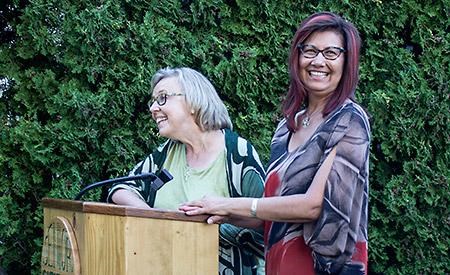With the announcement of a new candidate, Canada’s Green Party is seeking to grow the vote, not split it, according to its leader.
Green Party leader Elizabeth May spoke to a crowd of about 30 citizens at Cranberry Seniors Centre on Friday, July 31, in introduction Brenda Sayers as their candidate for North Island-Powell River.
“There’s no point in thinking that this mania, fear-based voting about splitting the vote is relevant,” said May, in an interview with The Peak, referencing the 75 per cent voter turn out in Saanich-Gulf Islands riding during the 2011 election. “There is a very clear relationship between giving someone something they want, engaging Canadians and getting higher voter turn out.
“There is no chance of a Conservative winning in this riding,” said May. “’It’s either going to be a Green or an NDP member of parliament in this riding.”
In the 2011 election Powell River, as part of the West Vancouver-Sunshine Coast-Sea to Sky Country electoral district, voted in Conservative MP John Weston with 45 per cent of the vote.
May forecasted a minority government in the October 19 general election, with a Green or NDP MP from North Island-Powell River.
“It’s a great opportunity for North-Island Powell River to choose to have the MP who will work hardest for them and know that in a minority parliament,” she said. “Green MPs from British Columbia, and across Canada, can have far more influence than a local MP who is told what to do by a party boss.
“We have a very strong platform in a lot of areas and we’re going to have to get it out there despite the fact that we are facing Conservative-NDP collusion,” said May, speaking to NDP leader Thomas Mulcair’s recent announcement that he will not appear in any of the televised consortium debates if Conservative Party leader Stephen Harper does not attend. That announcement puts the fate of the debates hosted by Canada’s three main television broadcasters into question.
Visiting Powell River in March, Mulcair said the NDP is in a three-way race with the Conservatives and Liberals to win the federal election.
Sayers is running in a federal electoral district created again in 2013 for the 2015 federal election. The riding, which stood from 1988 to 1997 elected NDP candidate Ray Skelly in 1988 and former Reform Party candidate John Duncan in 1993.
A member of the Hupacasath First Nation from Port Alberni, Sayers first met May in the fight against the ratification of the China Foreign Investment Promotion and Protection Agreement (FIPA) in 2012—a bilateral agreement which many argue could allow foreign companies to seek billions of dollars in compensation if their projects are hampered by provincial laws on issues such as environmental concerns or first nations rights.
Sayers is a business woman who has owned a service station in Vancouver as well as working with Hupacasath chief and council, one of the 14 Nuu-chah-nulth tribes extending across North Vancouver Island. She plans on taking the spirit of that fight with her forward into the 2015 election. At 11 weeks long it will be one of the longest campaigns in Canadian history.
“I’m up for it,” said Sayers. “FIPA was two and a half years, was a marathon….I have it in me to continue to do that, to get out and meet people and shake their hands to bring issues to the forefront.
“Every first nations and Canadian has a powerful reason to vote in this upcoming election,” said Sayers. “Climate change should be at the forefront of everybody’s minds in this election.”
The federal election will be held on Monday, October 19, 2015.



.jpg;w=120;h=80;mode=crop)